Surprise is the most short-term emotion. Surprise occurs suddenly. If you have time to think about the event and speculate about whether you are surprised by what happened or not, it means you have not been surprised. You can not be surprised for a long time, if only the event that struck you does not open for you with its new unexpected facets. The surprise never stretches. When you cease to be surprised, it often disappears just as quickly as it appeared.
A surprise is caused by both an unexpected event and an event that can be called pseudo- unexpected. Imagine the situation when the wife appears in the office of her husband. If she comes regularly at this time to bring her husband lunch, he will not be surprised - her appearance in the office will not be unexpected or mistakenly expected. If the wife rarely enters the office and the secretary, seeing her, says: “I see your wife on the street”, then the arrival of the spouse will not cause the husband surprise, because in this case he will have time to reflect on this atypical event and his reasons. But if the wife enters the office without prior notice and her appearance is perceived as something unusual, then this event turns out to be an unexpected surprise - an unusual event that was not foreseen. It is called the unexpected, and not pseudo-unexpected, because at this moment the person who is surprised is not expecting anything like that. Now suppose that instead of a coffee seller, who always comes to the office at the same time and always knocks on the door in a special way, a wife appears in the office. Such an event is a pseudo-unexpected surprise. Here arises a specific presentiment of something else that is about to happen at the moment. In the case of a pseudo-unexpected surprise, the event does not need to be really unexpected to be amazing; it is the contrast with what was expected at the moment that is the subject of surprise. If at the moment when a coffee seller is expected to appear, a secretary enters the office, this can also be surprising, perhaps insignificant. If the event opposite to the expected one turns out to be also unexpected, then surprise will be even greater. The appearance of his wife at the moment will seem more surprising than the appearance of the secretary.
Almost anything can be surprising, provided that it turns out to be either unexpected or mistakenly expected. Amazing can be a look, sound, smell, taste or touch. When a person bites off a piece of cake, the filling of which looks like chocolate cream, the taste of the filling of pork and mushrooms can be a surprise for him. Such a taste turned out to be pseudo-unexpected for him. But not only physical sensations are surprising. Unforeseen or mistakenly anticipated ideas, a remark or suggestion of another person may also be surprising. The same may be your own thoughts or feelings. The goal of many detective novels is not simply to arouse a sense of fear in the reader (this is the task of works describing all sorts of horrors), but also to surprise him with an unexpected denouement. For example, many jokes are based on erroneous people's expectations, and therefore jokes have an effect. The degree of your enjoyment of the anecdote you hear will depend on how intrigued you are by the plot and the final is surprised.
If you have time to foresee the event correctly, then you will not be surprised. Let's return to our example: if a husband could see his wife coming to the office, he would have been surprised at the moment when he noticed her on the street, but by the time she would knock on his door, there would be no surprise trace. He would not be surprised if he knew that his wife was going to go shopping near the office. Surprise persists only until you appreciate what happened. As soon as you determine the nature of the event that surprised you, you cease to be surprised. Usually there is a ready explanation: “I went shopping, but I ran out of money; I decided to go to you, I met a coffee seller on the way and brought you a glass of coffee myself. ” If the event is difficult to explain, the period of surprise stretches; you may feel confused, frightened, or decide that you are mystified. Suppose a woman is welcomed at the door by her husband, who she thought was killed in the war. Woman is surprised. But it disappears when a man explains: "I am your husband's twin brother" or: "I mistakenly hit the death toll, and after being wounded I suffered for a long time with amnesia." If the interpretation of an event turns out to be even more incredible than the event itself, then this woman may be surprised again, get scared or decide that she is mystified, for example, if a man says: “I am your husband's spirit. I came to talk to you. ”

As soon as you evaluate an unexpected or pseudo-unexpected event, a rapid transition from surprise to another emotional state occurs. “I am pleasantly surprised,” you say, not realizing that surprise itself is neutral in a hedonistic sense. Rather, it is the following emotion that gives a positive or negative tone to your experience, depending on the nature of the initial event. A surprise turns into pleasure or joy, if an event brings or promises to bring you something that you enjoy. Disgust follows a disastrous or unpleasant event. If an event provokes aggression, then surprise turns into anger. And if an event is fraught with a threat that you cannot weaken, then you experience fear. Fear is the most typical consequence of surprise, perhaps because unexpected events are often dangerous and many people associate any unexpected event with danger. Next, we show how people can confuse fear with surprise because of the similarity of the manifestation of these emotions on the face.
Since surprise is short-lived and another emotion quickly comes to replace it, the face often displays a mixture of surprise followed by emotion. Similarly, if a person is already experiencing some kind of emotion when an amazing event occurs, then a combination of this emotion with surprise is displayed on his face. An astute observer who draws attention to fleeting expressions can catch a pure expression of surprise. However, most of us are more familiar with the appearance of surprise in combination with elements of the second emotion. Thus, eyes wide open from astonishment can remain in this position for a moment, while the smile spreads over the lower part of the face. Or eyebrows can instantly rise from surprise, and the corners of the mouth drawn back will give a face an expression of fear. In the study of the emotions of fear, we show how fear and surprise are simultaneously reflected on the face; then we will show mixed expressions of surprise and disgust, surprise and anger and surprise and joy.
Surprise in degree of intensity can manifest from weak to extreme - depending on the event that caused it. The unexpected appearance of his wife in the office of her husband, apparently, will be less surprising than the appearance of an old childhood friend, with whom communication was interrupted many years ago. The startle response is regarded as the ultimate form of surprise, but it has specific characteristics that distinguish it from surprise. Fright appears on the face otherwise than surprise. The eyes are closed for a moment, the head leans back, the lips retract and the person "shudders." A sudden strong change in stimulation, best exemplified by the sound of a shot from a gun or a squeal of brakes, causes a startle response. Unlike surprise, when the correct anticipation of an event prevents the experience from gaining, the startle response can be triggered by the event you are expecting. Consecutive loud sounds of shots do not cease to cause a fright reaction, although this feeling itself and its manifestation weaken. Unlike the experience of surprise, which is neither pleasant nor unpleasant, the experience of fright usually turns out to be unpleasant. No one likes to be scared. Sometimes people talk about fear caused by someone's ideas or words, but these statements should be perceived rather as turns of colloquial speech. It is unclear whether a person can really be frightened by anything other than a sudden loud sound, a spectacle or a touch. You may be extremely surprised by someone's words, demonstrate the expression of extreme surprise on your face and describe what happened as a fright. Thus, the term "fright" is used to describe the reaction of marginal surprise, as well as for a reaction akin to surprise, but different from it. The fear reaction is also closely related to fear, and in the next part we will look at the difference between fear and surprise, and also continue the explanation of the relationship between fear and surprise, fear.
The experience of experiencing each of the emotions that we will discuss can be enjoyable. It is clear that joy is a pleasant emotion, but surprise, fear, anger, disgust, and even sadness can also be pleasant, although it is obvious that usually they are not. There are people who rarely get pleasure, feeling joy, and instead feel a sense of guilt or shame for the pleasure they receive. The enjoyment of emotions or the inability to enjoy them may be the result of education, but very little is known about how this result is achieved.
Of course, there are people who love to be surprised. An amazing party, an amazing gift, an amazing meeting give them pleasure. They organize their lives in such a way as to more often be able to experience surprise, looking for a new one. In the limiting version, a person “dependent” on surprise, enjoying the experienced surprise more than any other emotions, is forced to abandon planning his life — he seeks to disorganize it so that the ability to foresee events does not deprive him of the opportunity to experience surprise.
But there are other people who do not like to be surprised. They tell you: “Please never give me any surprises,” even if surprises may be pleasant to them. They do not want to be exposed to the unexpected. They organize their lives in such a way as to reduce the appearance of everything new in it and avoid situations in which they will not know which event will be next. In the extreme case, a person who does not tolerate surprises is engaged in abnormally detailed planning and taking into account all possible events; he will never recognize anything unexpected if he cannot make this unexpected predictable. Imagine a scientist who is afraid to be surprised: such a scientist can only confirm or disprove hypotheses, but he can never discover anything unexpected.
What a surprise looks like
To demonstrate typical facial expressions, we use photographs of two people, Patricia and John. Appendix I describes what tasks we set for ourselves, making these photos, how they were obtained and who these people are.
Each of the three parts of the face, expressing surprise, has its own external features. The eyebrows are raised, the eyes are wide open, the jaws open and then the lips open.
Brows

Eyebrows bend and rise. In fig. 1 (above) you see Patricia’s surprised eyebrows (B) and her eyebrows in a normal or neutral state (A). The skin under the raised eyebrows is stretched and becomes more visible than usual (arrow 1). Raising the eyebrows leads to long horizontal wrinkles on the forehead (arrow 2). These wrinkles do not appear in everyone. Most young children do not have them, even when the eyebrows are raised, and sometimes also absent in adults. Some people have horizontal wrinkles - grooves that are constantly present on the skin of the face - even when the brows are still, but usually these wrinkles appear in middle age. If these permanent wrinkles are on a neutral face, then they become even deeper and more noticeable when the eyebrows rise in surprise.
Although a person who is surprised is usually not only raised his eyebrows, but his eyes are wide open and the jaw drops, raised eyebrows can be observed on a neutral face. In such cases, facial expression no longer reflects emotion; it acquires other meanings, some of which may be related to surprise. In fig. 1 (below) you see surprised eyebrows on a neutral face (B) and absolutely neutral face (A). When eyebrows are held in a raised position for a few seconds, this facial expression becomes an
emblem of a doubt or question. Often a person does this by listening to what someone else is saying to him; thus, without a word, he expresses a question or doubt in what he is told. A question or doubt can be serious or not; often such an emblem expresses ironic doubt, skepticism, or astonishment of the listener about the words spoken. If this is complemented by a movement of the head to the side or back, we observe a silent exclamation. If a raised eyebrow is supplemented by a mouth twisted in a grimace of disgust, then the emblem takes on a slightly different meaning - skeptical disbelief or, if a person starts shaking his head back and forth, an incredulous silent exclamation.
In fig. 1 reveals something else that is very important when considering facial expressions. Patricia appears to be doubting all over her face, but this photo is composite. Raised eyebrows are only part of the previously modified neutral face shown in the left photo. If you close her eyebrows with your hand, then see for yourself. Despite the existence of many facial expressions, the change in only one area gives the impression that the other facial features have also changed.
If surprised eyebrows are held in a raised state for a very short time, this may indicate other values. If raising the eyebrows is accompanied by a tilting of the head or a slight movement of the head up and down, then we see the emblem of greeting, called raising the eyebrows; such an emblem found in Melanesia was named by one universal researcher. Quick eyebrow raising can also be used as a spoken “punctuation mark”. When a person says something, he can quickly raise and lower his eyebrows to focus attention on a particular word or phrase. Facial expressions emphasize the spoken words, just as italics do in printed text. Other eyebrow movements and movements of other parts of the face are also used as “punctuation marks”, which we will definitely talk about later.
EYES

Figure 2
On the face, expressing surprise, eyes are wide open, lower eyelids are relaxed, and upper eyelids are raised. In fig. 2 (left), with Patricia and John, surprised eyes; for comparison, in the right part of the figure, their eyes are shown with a neutral facial expression. Note that in a state of surprise, narrow strips of the whites of the eyes — the sclera — become visible between the upper eyelid and the iris (painted in the central part of the eye). The sclera may also be visible below the iris, but it depends on how deeply the eyes are set, and whether the lower jaw is lowered enough to tighten the skin under the eyes. Thus, when you see a protein below the iris, it is not as reliable an indicator of surprise as the appearance of the sclera between the upper eyelid and the iris.
Usually, surprised eyes are complemented by surprised eyebrows, surprised mouth or both at the same time, but sometimes they appear by themselves. When the upper eyelids are raised, showing the sclera in the absence of corresponding changes in the position of the eyebrows and mouth, this movement is almost always short-lived and lasts a small fraction of a second. Such open eyes can serve as a reflection of an instantaneous interest or as a supplement or substitute, for example, to such a word as “Great!” Widely opened eyes can also be used as colloquial “punctuation marks” that emphasize a particular sounded word.
LOWER PART OF FACE
At the moment of surprise, the lower jaw drops, as a result of which the teeth are opened and the lips open. In fig. 3 shows that the mouth parted in surprise is relaxed, not tense; lips are not closed and not pulled back. Instead, the mouth looks like it has opened in a natural way. The mouth can be opened only slightly, moderately slightly opened, as shown in fig. 3, or more widely disclosed, and this degree of disclosure depends on how strong a surprise is. We will give an example of such variations below.
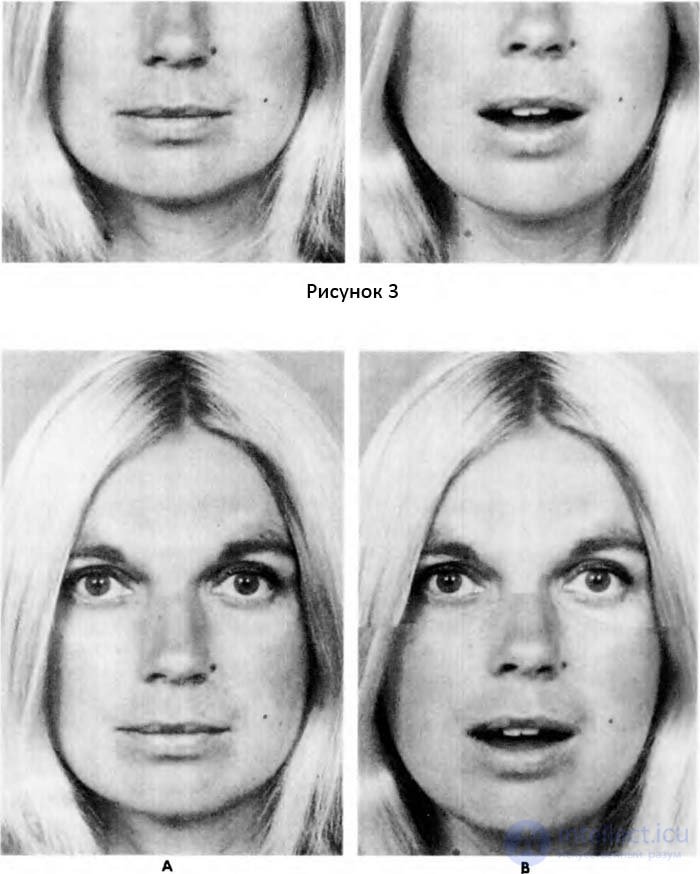
The jaw can go down without any movement of the other elements of the face. In fig.3 shows a face on which a surprise is reflected only in its lower part in the form of a lowered jaw, and for comparison, the same face is shown in a neutral state. The meaning of lowering the jaw is to express a daze. The lowering of the jaw could have happened if Patricia were really stunned by something; it can serve as an emblem if Patricia wants to declare that she was stunned at some point in the past; or it can be used to give a face a feigned expression when it wants to play a daze. Figures 3 and 1 show how changing one part of a face leads to a complete change in the expression of the entire face. Take a look at the eye area in Fig. 3B: A little more surprise seems to be expressed than in fig. 8A. But it is also a composite photo; if you cover your mouth in both pictures with your hand,then you will see that the eyes and eyebrows are the same in both photos.
FROM EASY SURPRISE TO THE EXTREME
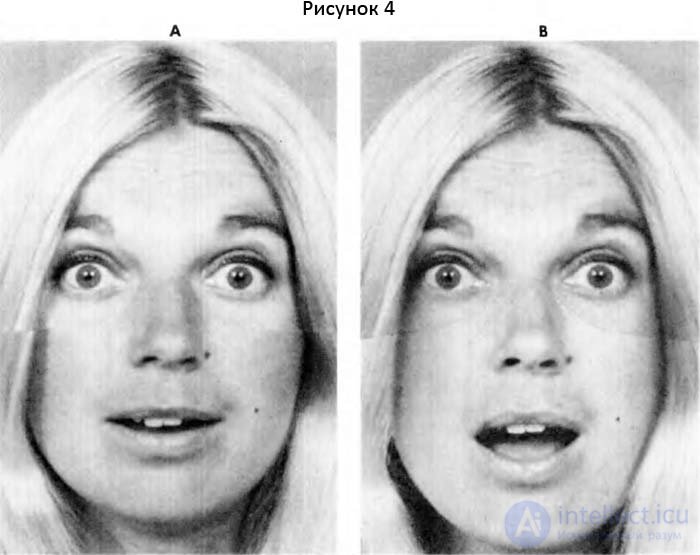
The surprise that is experienced varies in intensity, and the face reflects these variations. Although there are slight eyebrow changes (slightly raised) and an eye (expanding and opening a little wider), the lower part of the face is the main indicator of the intensity of surprise. In fig.4A shows a slight surprise, and fig. 4B - moderate surprise. Eyebrows and eyes in both photos look the same; only the lowering of the jaw changes. The stronger the surprise, the wider the mouth opens. Extreme surprise is often accompanied by exclamations like “O-o” or “Wow.”
FOUR TYPES OF SURPRISE
Surprise can be expressed through just two areas of the face, while the third area will remain neutral. Every face, on which surprise is manifested in two parts, has its own somewhat special meaning. In fig.5 shows four types of surprise. But before we begin to explain what message, in our opinion, is transmitted by each of these individuals and how the differences in the appearance of the person form these different messages, take a look at each of these photos and ask yourself: “What is this message?” And : “How does this face look different from other faces?”
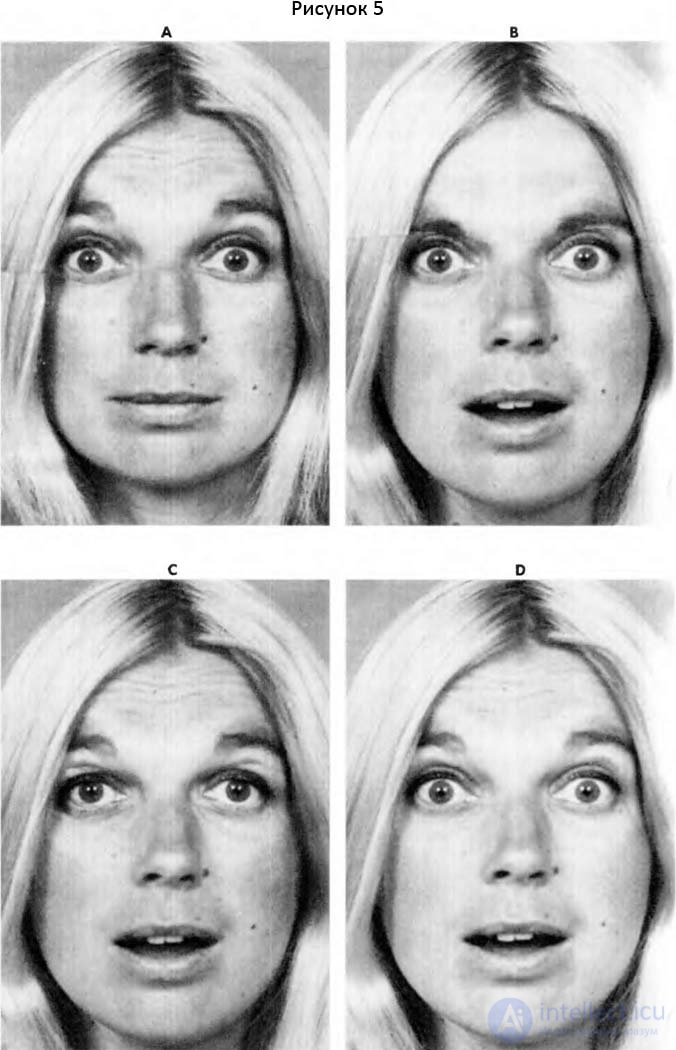
In fig.5A Patricia shows an interrogative surprise that is rather vague. This expression could accompany, for example, such words: “Is this so?” Or: “Oh, really?” It is exactly the same as shown in fig. 5D, with the only difference that in fig. 5D surprised mouth was replaced by a neutral. If you close your mouth with your fingers on the faces shown in fig. 5A and 5D, you will see that these faces are identical in everything except the shape of the mouth. Surprise looks questionable when the expression of surprise on the face is created only through the movements of the eyebrows and eyes.
In fig.5B Patricia shows astonishment that has reached astonishment. This facial expression may be accompanied by such words as “What?”, Or sounds like “Ah”, which are issued simultaneously with a quick breath. If you close your brow and forehead on the faces shown in fig. 5B and 5D, you will see that these faces are identical in everything except the closed parts - the areas of the eyebrows and the forehead. Surprise reaches amazement when it is expressed on the face only due to eye and mouth movements.
In fig.5C Patricia demonstrates a surprise, closer to a daze, or a less interested surprise, or a surprise that can be expressed on an internally devastated person or under the influence of drugs. If you close your eyes in pic. 5C and 5D, you will see that they are all the same, except for the eyes. A surprise looks like a daze when it is expressed only by the movements of the eyebrows and the mouth.
In fig.5D shows the expression of surprise created by the elements of all three areas of the face. The meaning of the message spread by such a person is one word - surprise.
SUMMARY

Figure 6
In fig.6 shows expressions of astonishment created by all three parts of the face. Pay attention to each of the hallmarks of surprise.
- Eyebrows raised and curved.
- The skin under the brows is taut.
- Horizontal wrinkles go across the forehead.
- Eyelids open; the upper eyelids are raised, the lower ones are lowered; the white of the eyes, the sclera, can be seen above the iris, and often under it.
- The lower jaw is lowered, so that the lips and teeth open, and the mouth is in a relaxed state.
“CONSTRUCTION” OF PERSONAL EXPRESSIONS
It is possible to consolidate the acquired knowledge about expressions of surprise on the face with the help of “constructing” the faces that you saw on this page. To do this, take photos with neutral facial expressions of John and Patricia (click to enlarge, save to your computer, and print). Cut each photo into two white lines. Now you have everything you need to create different expressions of surprise on the faces of Patricia and John.
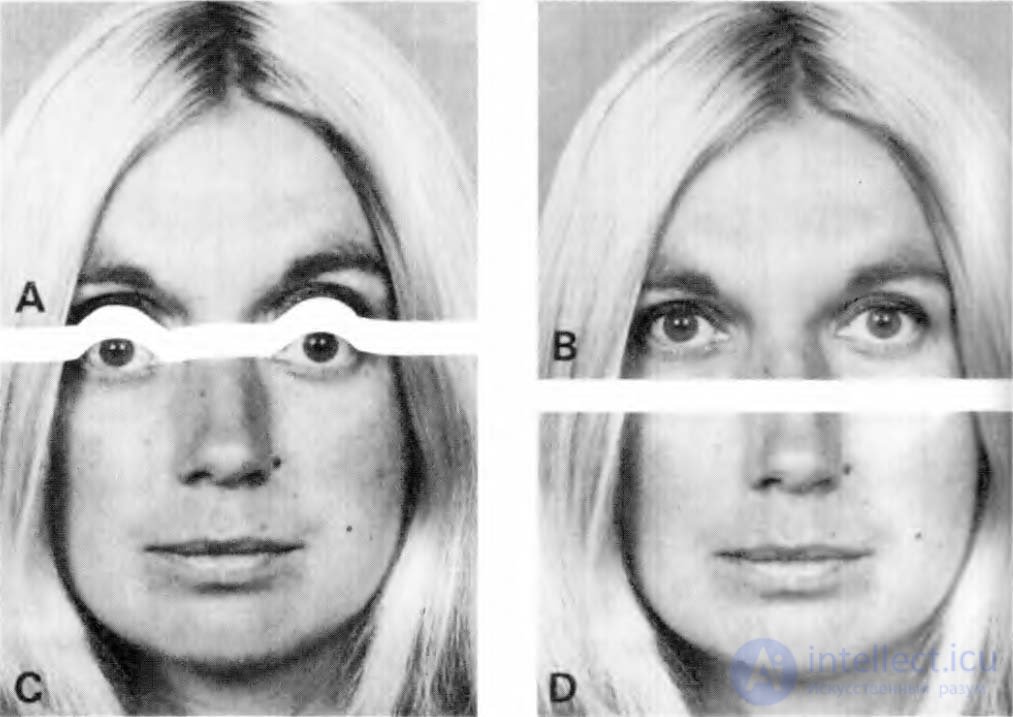 |
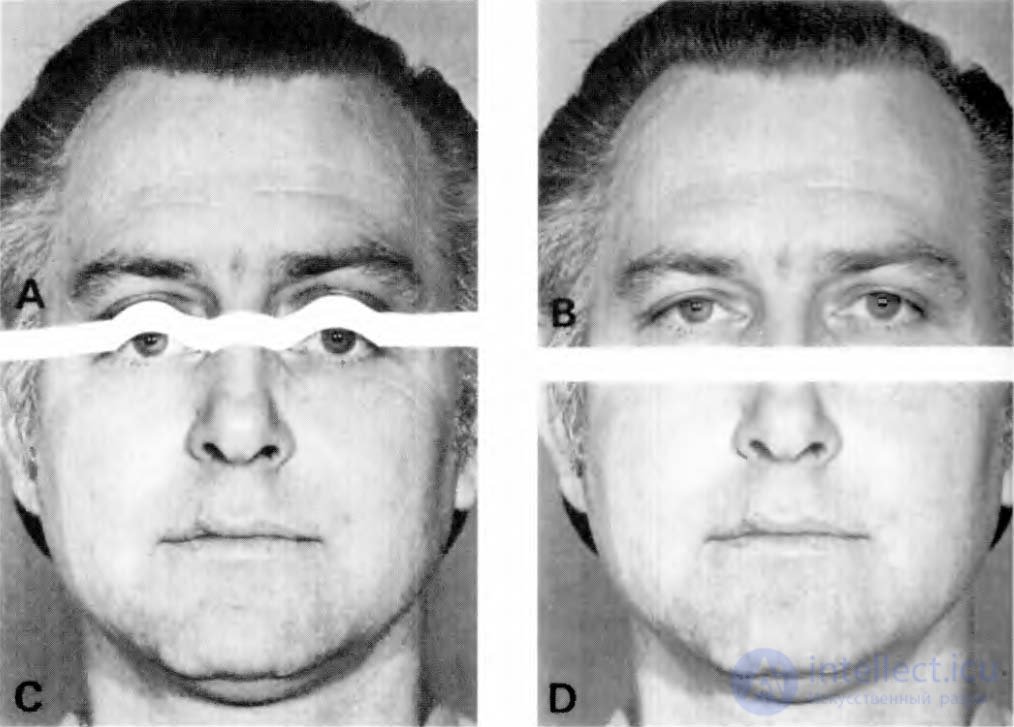 |
- Take the pieces C and place them on the faces in fig. 2. What was the facial expression in these photos?
You have already seen such a face in Patricia, but have not yet seen such a face in John. It expresses doubt or distrust (Fig. 1).
- Put parts B on faces in fig. 2. What is the expression now? You have seen such an expression in Patricia in fig. 8. John will have the same expression. This is an expression of daze.
- Наложите на изображения рис. 2 части А, а затем наложите части D. Такого выражения лица вы еще не видели, но мы поговорим о нем позже. Вы используете только удивленные глаза, и если выражение возникает лишь на какой–то миг, оно означает интерес или немое восклицание. Оставьте часть D там, где она лежит, и меняйте местами части А и C. Это создаст впечатление, что глаза перемещаются взад и вперед от нейтрального выражения к удивлению, как это и было бы в жизни.
- Оставьте только части А. Вы получите выражение изумления (рис 1B). Теперь верните части D обратно и удалите части А. Вы получите выражение вопросительного удивления. Меняя местами А и D, вы можете наблюдать, как изменяется смысл выражений лица.
-









Comments
To leave a comment
Psychology of emotions
Terms: Psychology of emotions